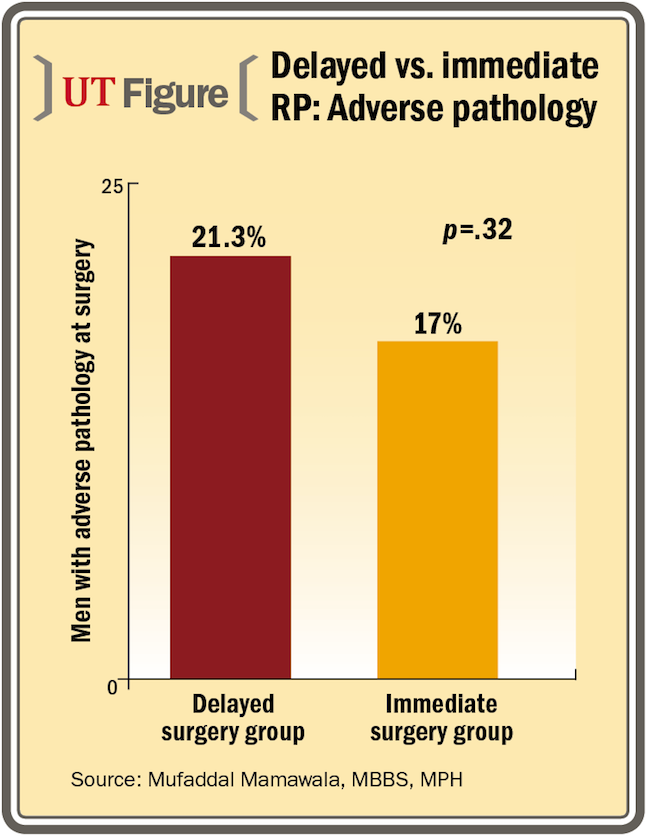Article
Men who delay RP show no added risk of adverse pathology
After accounting for the risk of reclassification, carefully monitored men with favorable-risk prostate cancer who enroll in active surveillance and undergo delayed surgery are no more likely to demonstrate adverse features associated with 15-year prostate cancer-specific mortality than their counterparts who elect immediate curative treatment, say researchers from the Johns Hopkins University Brady Urological Institute, Baltimore.

New Orleans-After accounting for the risk of reclassification, carefully monitored men with favorable-risk prostate cancer who enroll in active surveillance and undergo delayed surgery are no more likely to demonstrate adverse features associated with 15-year prostate cancer-specific mortality than their counterparts who elect immediate curative treatment, say researchers from the Johns Hopkins University Brady Urological Institute, Baltimore.
READ: Active surveillance for PCa has ‘hit the prime time’
Comparisons between the delayed and immediate surgery groups showed those having delayed surgery were significantly older and had a slightly but significantly higher PSA density at diagnosis. However, the proportion of men with adverse pathology at surgery (ie, primary Gleason pattern of 4 or 5, seminal vesicle invasion, or positive lymph nodes) was not significantly different in the delayed and immediate surgery groups (21.3% vs. 17%, p=.32). And, in an unconditional logistic regression analysis adjusting for age, PSA density, and distribution of very low-risk and low-risk men, there was no statistically significant difference comparing the delayed to the immediate surgery group in the risk of having adverse pathology (p=.13), reported study co-author Mufaddal Mamawala, MBBS, MPH.
NEXT: Addressing patient anxiety
Addressing patient anxiety
“Patient anxiety that delaying intervention could compromise the opportunity for cure is probably one of the reasons why there has been a low rate of enrollment in active surveillance,” said Dr. Mamawala, who is the biostatistician for the Johns Hopkins active surveillance program.
READ: Prostate Ca radiation therapy cost drivers analyzed
“The findings of our study should help to reassure men with favorable-risk prostate cancer about considering active surveillance,” added Dr. Mamawala, whose group presented the data at the AUA annual meeting in New Orleans.
Describing the study design, Dr. Mamawala explained that while previous studies have compared active surveillance candidates who underwent immediate and delayed surgery, the delayed surgery groups in those investigations were enriched in men who underwent intervention because of reclassification to higher grade and/or higher volume disease.

“Due to this limitation, these studies would overestimate the risks of active surveillance,” explained Dr. Mamawala, who worked on the study with H. Ballentine Carter, MD, and colleagues.
To avoid such bias, the authors designed their study so that the delayed surgery group would be representative of the entire active surveillance cohort in terms of distribution of reclassification characteristics. Using that approach, the delayed surgery group was comprised of 89 men selected from a total of 185 active surveillance patients who underwent delayed surgery. As in the overall active surveillance cohort, 64% of the men were not reclassified, 6.7% were grade reclassified, 18% were volume reclassified, and 11.2% were grade and volume reclassified.
Comparisons between the delayed surgery study group and the overall active surveillance cohort showed no significant differences between them in baseline age, PSA, PSA density, number of positive cores, maximum core involvement, year of diagnosis, or race.
READ: Biomarkers offer insight into PCa racial disparity
“The similarities between the two groups in their baseline characteristics shows that our delayed surgery study group was representative of the overall active surveillance cohort,” Dr. Mamawala said.
The immediate-surgery comparator group was comprised of 3,788 men in the Johns Hopkins database whose favorable-risk prostate cancer diagnosis was based on having at least a 12-core biopsy and who underwent surgery after 2004. That cutoff date was chosen to ensure modern pathologic grading.
NEXT: Retrospective design a limitation
Retrospective design a limitation
Discussing the limitations of the study, Dr. Mamawala mentioned its retrospective design and use of an intermediate endpoint that may not reflect true cancer-specific outcomes.
READ: Upfront chemo called ‘standard’ in hormone-naïve PCa
“We chose to analyze adverse surgical pathology defined by primary Gleason pattern 4 or 5, seminal vesicle invasion, or positive lymph nodes as an intermediate endpoint because a previous multi-institutional study showed the 15-year prostate cancer-specific mortality is primarily dependent on those three factors,” Dr. Mamawala said.
He also acknowledged that because of the low number of men in the delayed surgery group, the study had low power to detect a statistically significant difference comparing the delayed surgery and immediate surgery cohorts. In addition, men in the Johns Hopkins AS program are predominantly Caucasian (~90%), so the results of the study may not be generalizable to other racial groups or to individuals with higher risk disease.
Based on a comment made during the discussion of the paper, Dr. Mamawala noted that the active surveillance database includes information that can be analyzed to assess whether patients who undergo delayed surgery derive any quality of life benefits from starting on active surveillance.

Newsletter
Stay current with the latest urology news and practice-changing insights — sign up now for the essential updates every urologist needs.













